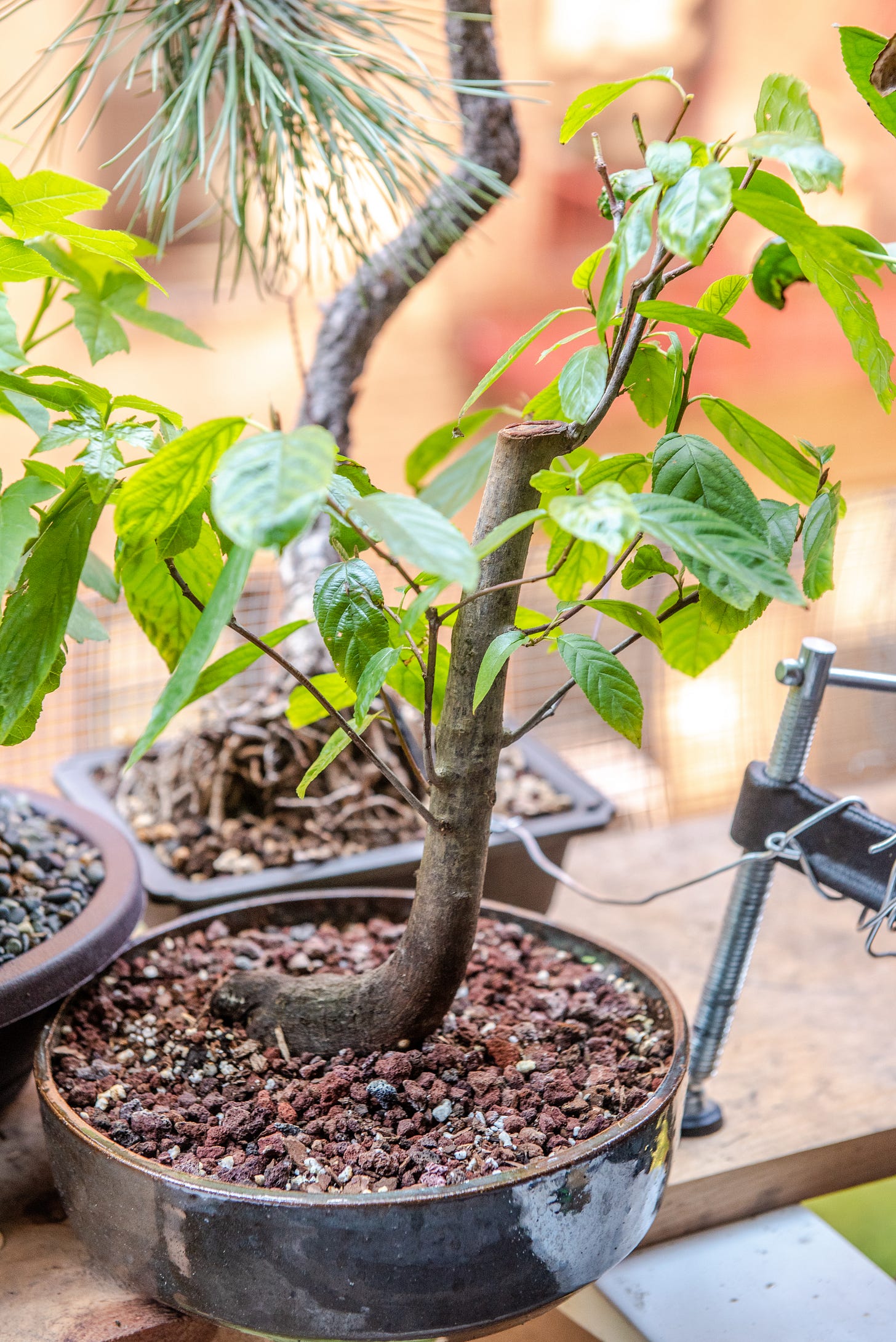How I learned to stop worrying and embrace native trees
On the geological succession of organic beings.
In response to recent death and disease among my current collection, I’ve treated myself to some new trees. For the last few months I’ve been thinking more about the role of native species in my bonsai practice, and for this round of purchases I sought out trees that are native to the New York City area. The chunky boy above is a liquidambar, also called a sweetgum. The city lies at the north of its native range and it’s a popular cultivated street tree here.
L. styraciflua is the only species of the genus in the Western Hemisphere, and it’s millions of years old. Liquidambars are known for their pretty fall color and fragrant resinous sap. There’s even a 16th century account from the Spanish governor of Cuba, who wrote of a visit from a Mayan delegation that brought “hollow reeds of about a span long filled with dried herbs and sweet-smelling liquid amber which, when lighted in the way shown by the natives, diffused an agreeable odour.”
So apparently you can smoke it.
There’s something about this viburnum nudum, also called smooth witherod, that I just couldn’t pass up. The shrub grows wild out on Long Island and also is supposed to have good fall color. This specimen reminds me of the Loch Ness monster rearing its head above the water, a graceful aquiline form that’ll look nice against brocaded white flowers that should bloom next spring. Like the liquidambar, it’s been chopped by a previous owner and has put out new branches. Here the branching is better positioned; my job now is to prune those branches back to a pair of leaves to encourage backbudding and ramification. But for now I’m letting it and the liquidambar get adjusted to their new home.
The most popular trees for bonsai are those that have a long history among Japanese practitioners. Many of them, like Japanese black pine, procumbens juniper, and Japanese maple, are native to, you guessed it, Japan. These trees are also well suited to bonsai, with dense branching, tight foliage, and a readiness to backbud. American maples by comparison have larger leaves and longer spaces (internodes) between leaves, which makes them harder to miniaturize in a pot.
American bonsai artists often use these Asian species for bonsai. They’re the stock most often available and there are proven methods to turn them into good specimens. But there’s also a contingent of bonsai people here who push for the use of American species, sometimes to the exclusion of all others. To vastly oversimplify one of their arguments: if bonsai is about forging a personal connection with nature, where better to start than with the plants all around you? I’m sure some of this is clever marketing, but I buy it. It’s good to have local pride in something tangible, to know that we coexist in the same ecosystem. There’s a relationship here, and we owe it to each other to work together. You could even say you’re providing beneficial resources to pollinators in your area, though on the scale of bonsai that’s mostly symbolic.
There’s also a practical consideration. A species that’s meant to live here is more likely to put up with my microclimate and the stress of bonsai cultivation. This is of particular concern to me as I get too much wind and not enough light out on my fire escape; some of my non-native trees are simply not happy. I’m seriously considering a move to somewhere in the neighborhood with some outdoor space, or if any Queens readers have tips on local community gardens that wouldn’t mind boarding some trees, hit me up.
Liquidambar apparently makes good bonsai, provided you work the branches right. I’ll be pruning them later this season before they harden off. Viburnum has less of a track record, but I’ve seen enough on forums to get me interested.
Clethra alnifolia I’ve seen almost nothing about.
This native shrub was a $30 nursery find. Apparently it responds well to hard pruning and it even puts out flowers in the shade. That’s all I could find online, but with a nebari and trunk like this, it’s worth an experiment. I chopped two of the three trunks in early spring when I got it. I plan to chop the third after the flowers bloom in a few weeks. The tree has put out all of three buds since chopping, all in the same worst possible spot. (I clumsily broke off one of the buds while handling the tree, because I have sausage fingers.) All I can do now is wait for more budding and keep the tree healthy. If it’s meant to be, it’ll backbud more. If it doesn’t, I’ll plant it in my dad’s backyard as a shrub.
Tree reading
Call it t(r)ea reading: I wrote a little guide to the different types of tea this week, from the perspective of plant cultivation and processing. Maybe you’ll like it! [Food & Wine]
A suburban property line dispute in the UK has resulted in a tree split down the middle, as if by Solomon himself. [New York Post]




